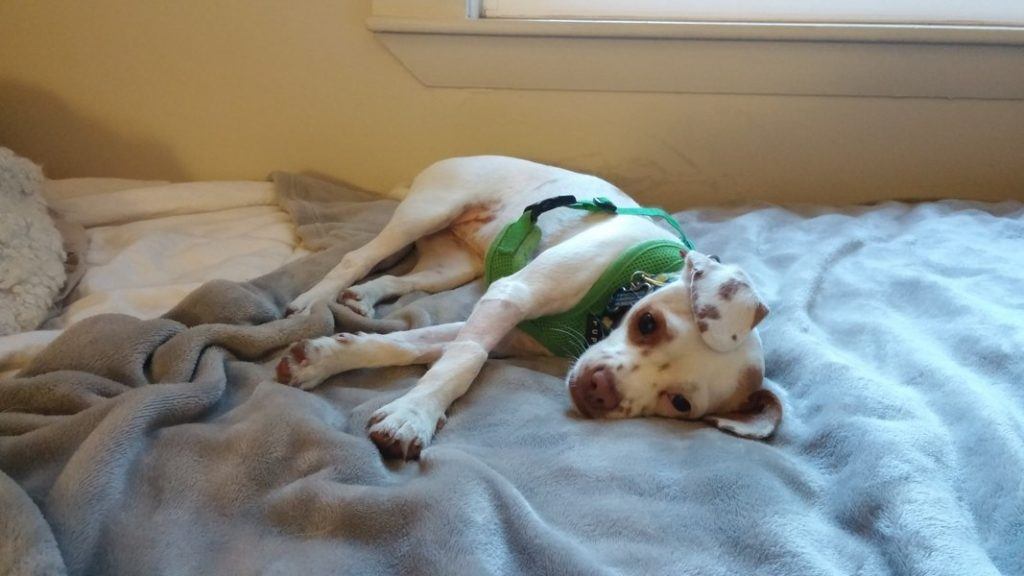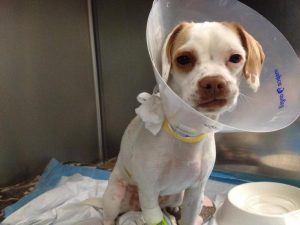“This post contains affiliate links, and I will be compensated if you make a purchase after clicking on my links.”

by Sara Estan
It’s close to midnight. You’re out on a first date and everything is going beautifully. Three glasses of wine into the night, you receive a text: “…I think your dog ate some Motrin.” Okay. Are you missing something? Is this a big deal?
“The Animal Poison Control Center told me it’s really, really toxic to pets…you need to get her to the emergency vet tonight.” Your stomach sinks. These things happen to other people, not you. How could it be toxic, you think to yourself—isn’t it meant to relieve pain, not cause it?
On May 16th, 2015, this exact scenario happened to me. Drunk, infatuated, and not quite connecting all of the life-threatening dots, I valiantly rushed (okay, I stumbled) to the nearest emergency animal hospital to get my 10 lb beagle mix, Lana, in for treatment. They’ll probably just pump her stomach or something and we can all go to bed after that, right?
Not exactly.
After taking my baby girl away to be seen, I waited. And waited. I pretended everything was fine. Finally the vet comes back out and he mentions a lot of scary sounding terminology I didn’t immediately understand. My first thought was “he’s trying to scare me, this just means more money for him!” But as he continued explaining and, quite frankly, begging me to keep her with them for extended treatment, it finally sank in.
At 3:00 AM on May 16th, 2015, my Lana’s life was in danger. The veterinarian let me say good night to her before leaving. I swear could hear her heart beat from a mile away. She was scared, confused, reaching for me through the cage. Being so small, I could very well lose her and never get to kiss that sweet little face again. Nothing sobers you up quite like that.

Over the period of the next three days, I tried to busy myself with learning about NSAID toxicity as word of Lana’s treatment and progression would come only twice daily.
By ingesting Motrin, an over the counter non-steroidal anti-inflammatory drug, or NSAID, I learned that Lana was at risk for stomach ulcers, kidney failure, or even death. NSAID’s work by preventing enzymes called prostaglandins (see? scary sounding terminology!) from providing blood to the stomach and kidneys which, in humans, is virtually harmless. Pets, such as dogs or cats, are much more sensitive to this effect of inhibiting blood flow to the stomach and kidneys. Without sufficient blood flow, the stomach can’t produce its protective lining and its acids start doing damage. That damage leads to ulcers which can cause vomiting—a big symptom of NSAID toxicity.
If enough Motrin (or Advil, Nuprin, Ibuprofen, etc) was ingested, the toxicity could be severe enough to move on to the kidney where it will cause the death of vital tissues. Without those tissues, the kidney can’t function properly and goes into renal failure. The toxins that are usually filtered out of your system by a healthy kidney are left free to roam and build up their toxicity elsewhere in the body, causing all sorts of internal ruckus. In extremely severe cases of toxicity, the brain starts to become effected and can cause tremors and seizures in the pet.
Thankfully, there is treatment for NSAID toxicity. The vet explained to me that they would induce vomiting to see if Lana could spit up the pills. Upon vomiting, nothing was found. The medication could be absorbed into the bloodstream entirely within just a few hours, the vet explained to me, which is why it was safest to assume she had ingested than not. Charcoal can also be given to your pet to absorb any undigested pills left in the stomach. Lana was put on IV fluids to essentially drown out the kidneys, restore circulation, and supply medication to the stomach and kidneys. IV treatment can dramatically increase your pets chances of recovering from toxicity, and recovery is always the veterinarians goal.
Doctor Lisa Benson of the Angell Animal Medical Center at the MSPCA in Boston, MA, offered me wise words during this difficult time: “An ounce of prevention is worth a pound of cure.”

Dr. Benson meant that prevention, such as keeping medications tightly sealed and away from mischievous four legged friends, is worth avoiding having to put your pet through treatment by leaving it within their reach.
Knowing your pet is in capable, confident hands makes the process that much easier. Immediate treatment is the best treatment, and educating yourself is the best form of prevention. Needless to say, those days I spent without Lana were eye opening. Watching her squirm and hearing her cry out when they released her back to me was the best feeling in the world. A week later, Lana is healthy and happier than ever, with a new found appreciation of her home and myself a deeper appreciation of her.
If you enjoyed hearing Lana’s story and took away something valuable from this article, please consider visiting, reading, sharing, or donating to Lana’s GoFundMe page for her treatment costs. Her page is updated frequently.
And, to learn more about Lana’s ordeal, her treatment, and to help spread awareness about the dangers of NSAIDS to our dogs, follow The Mischievous Motrin Muncher on Facebook right here.
As Benson said, “An ounce of prevention is worth a pound of cure.” Every dollar helps, and every share of her story is invaluable. Thank you for reading.
Sources:
Brooks, C. Wendy, DMV DipABVP. “Ibuprofen Toxicity,” The Pet Pharmacy 01/31/2012. Online.
Benson, T. Lisa. Personal Interview. 20th May 2015
Animal Poison Control Center (888-426-4435)

















